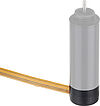Absolute encoders
Absolute encoders from FAULHABER detect the position of the shaft immediately after switching on. This can make a reference run unnecessary – an important prerequisite for many applications. Additionally, absolute encoders can be used to commutate brushless DC-motors. This eliminates not only the integrated Hall sensors for the motors but also reduces the wiring requirements. Like all components from FAULHABER, the encoders have an extremely compact design. Integrating them in drive results in either none or only minimal increase in the overall length.
Absolute encoders, also known as absolute rotary encoders, detect rotational or angular movements and convert them into electrical signals. Unlike the incremental encoder, an absolute encoder determines absolute positions, not relative positions. After switching on the absolute encoder, an absolute return value is available for each position of the motor shaft. If the encoder is moved mechanically while in the switched-off state, the current position can be read out immediately and directly after switching the voltage supply back on again.
A distinction is made between single- and multi-turn encoders. The absolute encoders from FAULHABER are all based on a magnetic measurement principle.
A magnet on the motor shaft moves with the motor revolution, and its magnetic field rotates with it. This rotating change is detected by a sensor and is output by the encoder's electronics. The position of the shaft can be derived from this value. The magnetic measurement principle is insensitive to dust and is generally very robust.
The rotating magnetic field is generated by a two-pole sensor magnet that is fastened to the motor shaft. Located above the sensor magnet is an encoder chip. In addition to sensors, it contains additional components that are necessary for signal processing. The analog signal of the sensor magnet detected by the sensors is received by the electronics and processed into a high-resolution encoder signal.
The absolute encoders from FAULHABER deliver absolute angle information with a high resolution of 4,096 steps pro revolution.
In combination with a brushless DC-motor, a rotary absolute encoder also performs the commutation. This eliminates the need for the digital Hall sensors that would otherwise be integrated in the motor. Besides, just three instead of eight cables are needed for the motor wiring here. The absolute angle information is available immediately after switching on. The devices are equipped with an SSI interface and use the BISS-C protocol for communication.

The single-turn absolute encoder is fully integrated in the motor. It can be combined with the small brushless DC-servomotors of the 0824...B and 1028...B series. The integration results in no change to the length of the motor.
The single-turn absolute encoder can be combined with motors of the B series starting at a diameter of 24 mm, BX4 and BP4. It is equipped with a Line Driver that eliminates electromagnetic interference during signal transmission. This makes the encoder also suitable for applications in which the signals need to be transmitted over longer distances.
The AEMT-12/16 L multi-turn absolute encoder not only detects the position within a revolution but also uses an additional counter to detect the number of revolutions. As a result, referencing is no longer necessary. With an external buffer battery, the absolute position including the multi-turn information is stored even in the event of a power interruption. The device has a 16-bit multi-turn resolution and can be combined with motors of the B series starting at a diameter of 24 mm, BX4 and BP4. The integrated Line Driver eliminates electromagnetic interference and ensures reliable signal transmission over longer distances.
Single-turn encoders indicate the position of the motor shaft within a revolution. Each position corresponds to a specific output value. After a complete revolution of the motor shaft, these signals repeat. For travel distances of more than one motor revolution, it is therefore necessary to perform a reference run after a power interruption.
A multi-turn encoder, on the other hand, has its own additional counter and is thereby able to detect the number of completed revolutions as well. As a result, an absolute position value over multiple shaft revolutions is available at any time. Referencing is generally not necessary if the maximum amount of revolutions is not exceeded. This aspect is a decisive advantage in many applications: A reference run may be extremely complicated or practically impossible with multi-axis or linked applications. The same applies for difficult-to-access applications.
It is first necessary to decide whether a single- or multi-turn encoder is needed. Furthermore, the absolute rotary encoder, as part of the drive solution, must be compatible with the motor. Each of the encoders from FAULHABER is designed to be combined with certain motor types.
With our Drive Calculator, you can easily find the drive solution with the appropriate encoder that best matches your requirements. You can find detailed information about selecting the optimum encoder in our webinar about encoder selection. Our sales team will be happy to provide you with an individual consultation.